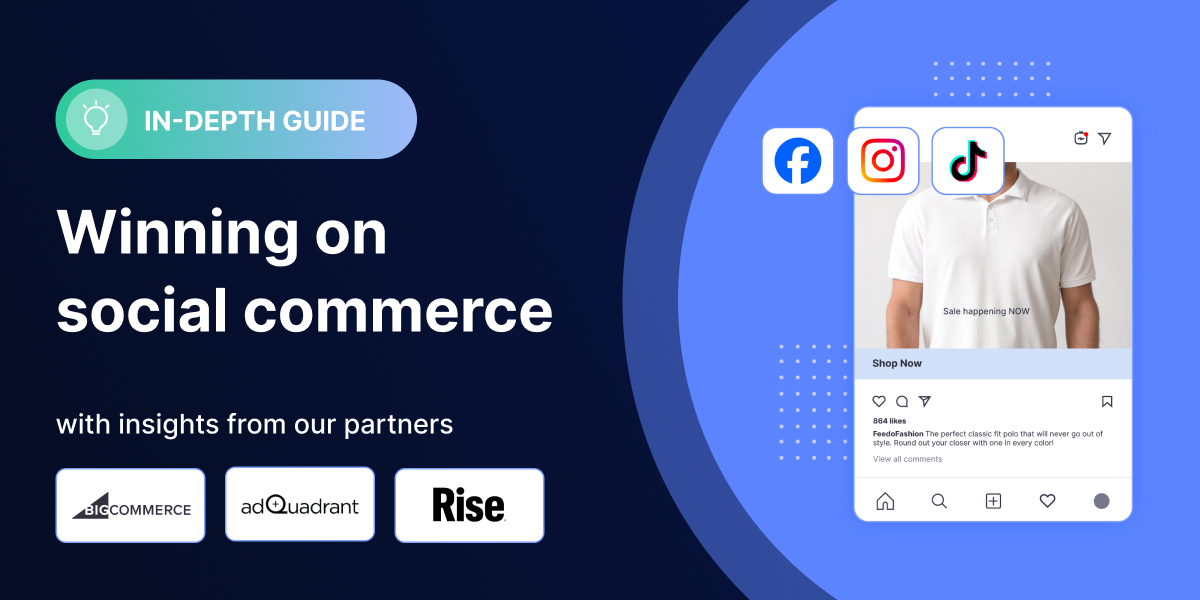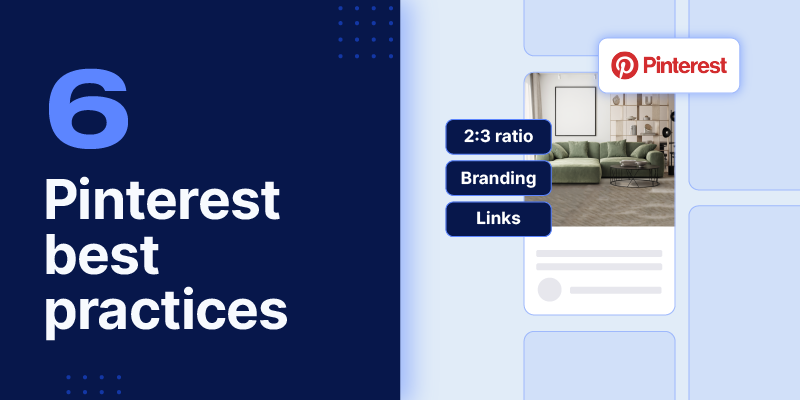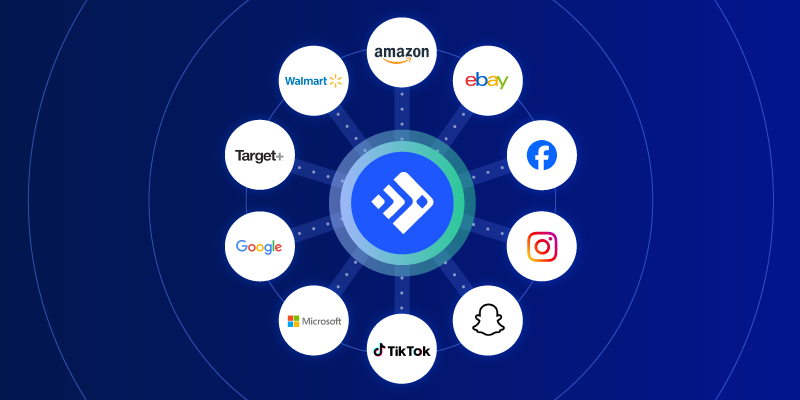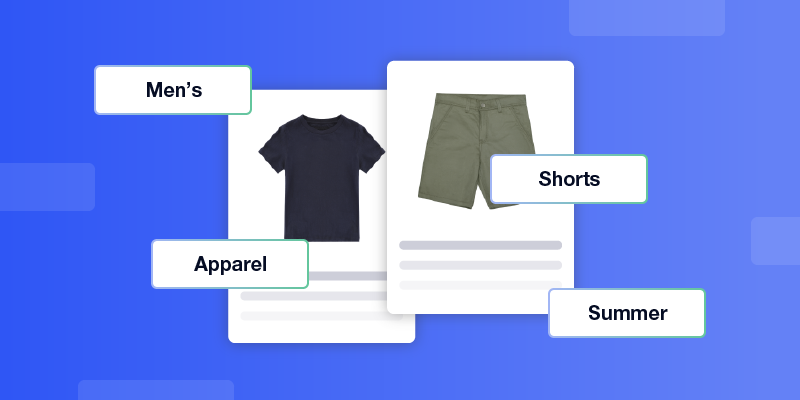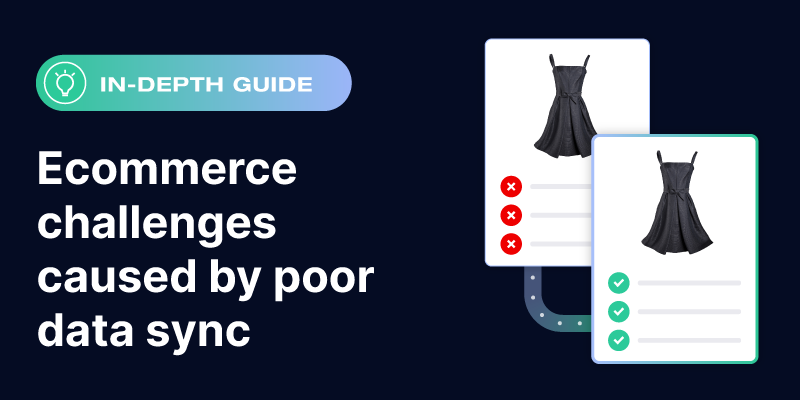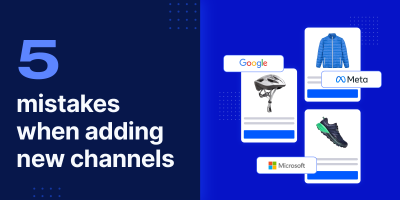Social commerce channels like Facebook, Instagram, and TikTok allow users to go from consuming their favorite content to making a purchase all on the same platform, making them ideal for engaging with customers, growing your brand, and creating visual campaigns that drive sales.
In fact, nearly 85% of shoppers review at least one social media site before making a purchase.
With that kind of buying influence, it’s pivotal to make social commerce a meaningful part of your omnichannel strategy.
In this blog, we show you what it takes to win on popular social commerce channels, with help from our partners at BigCommerce, adQuadrant, and Rise.
When we say “winning,” we mean optimizing your product data, structuring your campaigns effectively, and using unique social commerce features to bolster your branding.
This social commerce blog is the third in a series that includes contributions from industry experts about how to win on a variety of key shopping destinations:
- Winning on marketplaces
- Winning on search channels with shopping ads
- Winning on affiliate channels
- Winning on SMS and email marketing channels
Stay tuned for blogs about affiliate channels and SMS and email marketing in the coming weeks to round out your knowledge.
Brand building
On social commerce channels, sellers typically focus on audience engagement and building a distinct brand personality that resonates with their target community. This differs from other channels like search and marketplaces, where the approach is more product-centric, highlighting features and benefits.
“The types of products that do best on social commerce are those that: 1) lend themselves to impulse buying 2) have a lower price 3) produce a clear outcome in a short period of time—whether solving a problem or achieving a goal 4) and clearly address the aspirations of the target customer.”
Bonus tip from our feed specialists:
Traffic and conversion rates for sellers on social commerce channels lean heavily on social tools like tagging posts, creating new posts consistently, and promoting through influencers, which traditional marketplaces don’t offer.



Social commerce platforms encourage direct interaction with your audience through comments, likes, shares, and direct messaging. Brands can leverage user-generated content (UGC) and influencer collaboration to build trust and drive customers to their in-platform shops. These storefronts often give you a branded, customizable page where you can display products and even allow browsing customers to chat with you directly.
“Maintaining consistent branding across all social media channels is crucial for building a strong, recognizable brand. Use consistent color palettes, fonts, and imagery across all platforms and ensure that the tone, voice, and messaging align with your brand values and resonate with your target audience.”
You have plenty of creative freedom on social commerce channels to tell your brand’s story, show how your product works, and engage customers in promotions like giveaways and challenges. You can choose from a wide variety of media like multi-image sliders, short video reels, live video streams, and even augmented reality (AR).
In contrast, content on search and marketplace channels is more standardized and functional, focused on providing informative, product-specific content to aid customer decision-making and enhance product visibility.
Understanding platform culture and the tools at your disposal
“Brands should focus on developing more platform-specific strategies—really diversifying their content and not using a one-size-fits-all content strategy. They should also utilize the shopping features available on each social channel, as they're all a little different.”
 Instagram
Instagram
Instagram is a highly visual platform with a heavy aspirational and lifestyle-focused culture. It’s a good platform to post lifestyle images and videos, product highlights, and behind-the-scenes content. The Instagram Shop allows brands to tag products in their photo, video, and carousel posts, enabling users to click on tags to view product details and purchase directly within the app.
- Photo, video, and carousel posts: Share up to 10 images or videos up to an hour long.
- Instagram Reels: Create short, 15- to 90-second videos that can reach a wider audience through Instagram’s dedicated Reels feed.
- Instagram Stories: Use polls, questions, and swipe-up links to engage with followers and drive traffic to product pages with limited-time content that disappears after 24 hours.
- Instagram Live: Broadcast real-time video to interact directly with your followers, answer questions, and showcase products or events as they happen.
- Instagram Shop: Create a customizable storefront where users can browse and purchase products directly through Instagram.
 Facebook
Facebook
Facebook is more community and discussion-oriented. Users keep in touch with a wider network, share news, and participate in groups. Brands should concentrate on creating diverse content that includes promotional updates, stories, and live events to build a strong connection with their audience. Facebook Shops enables brands to tag products in photos, videos, and stories, making it easy for users to discover and purchase them.
- Photo, video, and text posts: Share photos, videos, and text updates on your Facebook page or profile.
- Facebook Stories: Post photos and short videos that disappear after 24 hours to share quick updates on your Facebook page or profile.
- Facebook Live: Stream live video to interact with your audience in real time, answer questions, and provide immediate updates or coverage of events.
- Facebook Groups: Create communities around shared interests or topics where members can engage in discussions, share content, and build connections.
- Facebook Shops: Set up a customizable online store on Facebook, allowing users to browse and purchase products directly through the platform.
 TikTok
TikTok
For TikTok, brands should focus on creating short, engaging, and creative videos that leverage trends, challenges, and UGC to capture the audience’s attention. Brands can use regular TikTok videos, live broadcasts, and duets to engage with users, participate in trends, and showcase their products in fun and innovative ways. TikTok Shopping integrates with video content, allowing brands to add product links directly to their videos and live streams.
“TikTok users are accustomed to discovering new products and services on TikTok and welcome brands to participate. It is distinctively important to make creative that is native-feeling to TikTok. Through iterative testing, we know that TikTok ads are more effective if they look less like an ad and more native to the platform. Make TikToks, not ads.”
- TikTok Video: Post short, creative videos (now up to 30 minutes long) with music, effects, and editing tools to engage and entertain.
- TikTok Live: Broadcast live video to interact with followers in real time.
- Creator marketplace: Partner with popular TikTok influencers to reach a broader audience.
- TikTok Shopping: Integrate product links directly into your TikTok videos, allowing users to shop and purchase products seamlessly within the app.
“For TikTok Shopping, I recommend finding creators that will resonate down to the product level. Work with creators with some previous traction in driving Gross Merchandise Value (GMV). Analyze the performance of each creator, to identify your top performers and engage them proactively. Obsess over what is driving GMV today in terms of content approach and creator type.”
 Pinterest
Pinterest
Pinterest acts as a visual discovery tool, so brands should focus on visually rich and inspiring content that aligns with the interests and projects of their audience. DIY ideas, home decor, and fashion are all popular on the platform. Brands can use pins to share product images, lifestyle images, step-by-step guides, and video content to provide value and inspiration. Pinterest Shopping integrates with these pins, allowing brands to turn them into shoppable content.
“Pinterest is the platform for inspiration. It helps people find useful, relevant ideas—and then bring them to life.”
- Static Pins, Idea Pins, and Video Pins: Share different types of pins to inspire users with static images, idea pins with multiple pages of content, and video pins to showcase more dynamic content.
- Rich Pins: Provide additional details directly on the pin, such as product information, recipes, or articles, to enhance user engagement and drive traffic to your website.
- Collection Pins: Group multiple product-related pins together in a single post, allowing users to browse and discover more content around a theme.
- Try-on product Pins: Use AR to let users virtually try on products, enhancing the shopping experience and helping them make more informed purchasing decisions.
- Pinterest Shopping: Enable users to browse and buy products directly through Pinterest, turning pins into purchasable items.
 Snapchat
Snapchat
Snapchat is a more personal platform, known for its time-limited posts and playful lenses and filters. Brands should leverage the fleeting nature of Snapchat content to create a sense of urgency and lean into less polished and more spontaneous content. With Stores, your audience can discover, browse, and shop for products directly from your Snapchat profile.
- Snaps: Send images or short videos directly to your audience which disappear after being viewed.
- Stories: Stories can contain a series of Snaps that last only 24 hours and play in the order they are posted.
- Lenses: Brands can create custom selfie Lenses and shoppable try-on AR experiences via Lens Studio. Lenses can be made to respond to a user’s actions, like when they blink, move the camera, or open their mouths.
- Filters: Brands can create filters, which are usually static overlays that add effects or information to a photo or video after it has been taken. They can also be enabled based on a user’s location.
- Snapchat Store: A brand with a verified public profile for businesses and a catalog will be able to include a Shop tab on their profile leading to their Store. With Stores, brands can create a new sales channel in their public profile, enabling Snapchatters to discover, browse, and shop products directly from their Snapchat profile from the Shop tab.
Managing social commerce feeds
A product feed is a file that contains all the product data needed to create product listings online. It includes information like product titles, descriptions, images, and other important attributes like color, style, pattern, inventory, and price. Product data feeds play an important role in social commerce selling:
- They’re used in ad formats like carousel and collection ads on Meta.
- They’re required to keep inventory, pricing, and other attributes up-to-date, providing accurate information to potential customers.
- Platforms use them to match products with the right users based on their interests and behaviors.
- They’re required to maintain a smooth integration between your ecommerce platform and the social commerce channels you sell on.
- They contain the information your customers need to make purchasing decisions.
The role of product data in social commerce shops and ad campaigns
Shoppable posts
Product feeds are the backbone of shoppable posts, providing the necessary product information to display them, ensuring that information is up-to-date, and helping connect your ecommerce platform with your social commerce storefronts.
Dynamic product ads (DPAs) and collection-type ads
“In order to build the ideal digital store, you need products, and you need them to always be up-to-date. Collection ads and DPAs are two fundamental ad units that help make this digital in-store experience happen. Both of these ad types: 1) personalize the shopping experiences with the most relevant product for the user 2) use product catalogs that are powered by feeds to showcase those relevant products 3) and leverage a product feed to manage the “inventory” displayed.”
Dynamic product ads are personalized ads that automatically promote products to individuals based on their past interactions with a brand’s website or app. These dynamically generate content for each user, displaying the most relevant product to them.
For example, on Meta, ecommerce sellers have the ability to use two different dynamic product ad formats:
- Collection ads that feature a manually uploaded hero image or video, with dynamic product images appearing in a row below it.
- Carousel ads that are purely dynamic, in that they don’t have any “fixed” creative asset attached, and only pull product sets from your catalog.
Optimizing product data for social commerce
Product titles
Since titles on social commerce channels tend to run shorter for mobile devices, you might have to tailor them to fit platform-specific guidelines so that they don’t get truncated.
Bonus tip from our feed specialists:
On Facebook, short titles of 65 characters are best. Pinterest titles can be 500 characters long instead of Google’s 150 characters, so you can maximize the keywords in the titles (without stuffing keywords).


You also want to ensure your titles are optimized by incorporating essential information like brand name, product type, sizing, and colors, as well as relevant keywords and features that make your product stand out.
Product images
Product images are crucial for engaging customers and driving conversions in social commerce. Good images attract attention and quickly convey product details.
Use high-resolution images, including multiple angles, and have some lifestyle shots handy to help customers connect with the product.
Bonus tip from our feed specialists:
For TikTok and Instagram, it’s best to send 1-to-1 ratio images if possible.


Try to keep backgrounds simple and uncluttered to make products stand out, and maintain a uniform style in lighting, background, and framing.
Product categories
Accurate product categorization ensures products appear in relevant searches and helps platforms match product ads with the right users. Don’t forget to subcategorize products properly to improve the platform’s efficacy in matching them with users and showing them among related items.
Bonus tip from our feed specialists:
Snapchat accepts Google-formatted feeds and has its own version of the pixel and a pixel helper. Facebook has its own categorization field that can be used in combination with Google Product Categories. These Facebook categories are more granular and gender-specific than Google’s categories.


Leveraging a product feed management platform
If you have a large product catalog, you need a way of effectively managing your product feeds to succeed. A feed management platform can help streamline various ecommerce processes, like product listing, optimization, categorization, and data synchronization.
“We can’t overemphasize the importance of setting up your product feed. Collection ads and DPAs are best leveraged with a dynamic product feed integration. The feed integration process varies by platform, but this will fuel the entire shopping experience from consumer consideration right to the product detail page and checkout on the platform itself. Automation tools allow marketers to focus on pushing the strategy limits and more efficiently drive superior results. Using a feed management tool makes sure your product data is updated in real time, so your ads always display current products and pricing, as opposed to continuously manually uploading.”
Syncing an ecommerce catalog for shoppable posts
To make shoppable posts possible, it’s essential to sync your ecommerce catalog with the social commerce platforms you sell on.
A feed management platform ensures that your product data is consistently updated across all channels. This includes product titles, descriptions, images, prices, and inventory.
Automating product data optimization
Optimizing thousands of SKUs manually isn’t feasible for most brands. By leveraging automation tools in a product feed management platform, you can transform your product data in bulk to match channel-specific requirements for titles, descriptions, categories, and other crucial attributes.
Dynamic images
Use automatic image padding and dynamic processing to ensure that your product images meet the requirements of the channels you sell on. This allows you to utilize the images you already have, without having to manually edit each one.
Additionally, some feed management platforms come with advanced features that allow you to dynamically add text and overlays to images based on the data in your product feeds.

Order management
Some feed management platforms have order management technology that automates order synchronization and data translation across multiple channels, ensuring that your inventory levels are always accurate, and that orders are available to process in a centralized system.
You can also reduce the risk of overselling during promotions by using inventory buffers, which allow you to control how much inventory is displayed on a marketplace.
Building social commerce campaigns
According to adQuadrant, there are several keys to a successful ad strategy on social commerce channels:
- Understanding your audience—including their pains, goals, what influences their decision-making—and awareness of the problem and your solution.
- Having a system for finding creators at scale who produce content that resonates with your target audience.
- Creating an attractive arrangement that is beneficial for your creators, your brand, and the customer in terms of compensation, offers to the customer, and program profitability.
- Leveraging platforms that make it easy to activate the program, like TikTok Shop.
- Having a planning and measurement strategy in place to understand the investment in the program, track the progress, and scale based on the numbers.
These are some of the biggest mistakes sellers often make on social commerce platforms:
- Not engaging enough creators.
- Not being crystal clear on the profitability of the program down to the contribution margin level.
- Not having a clear plan to measure the impact of social commerce on platform and across all channels, and assess profitability considering these data points. For example, seeing TikTok Shop lift and also seeing lift on Shopify and Amazon GMV.
- Not creating a game plan to support creators in creating the best content possible with additional tips, examples, and trend data.
Knowing your audience and tailoring your campaign structures
Audience targeting on social commerce platforms can be highly personalized, leveraging user data to display tailored content and ads. For example, with Meta, brands can segment their audience based on interests, demographics, and behavior.
“Ecommerce brands typically have two types of customers: those who are very in-the-know, and those who need a nudge. Rise’s audience-first campaign structures are built according to the specific customer type. Whether we’re talking to existing customers, known prospects, or net new buyers who have not yet engaged with your brand, we build campaigns so the users see tailored messaging based on where they are in their purchase journey, and then allocate budgets accordingly.”
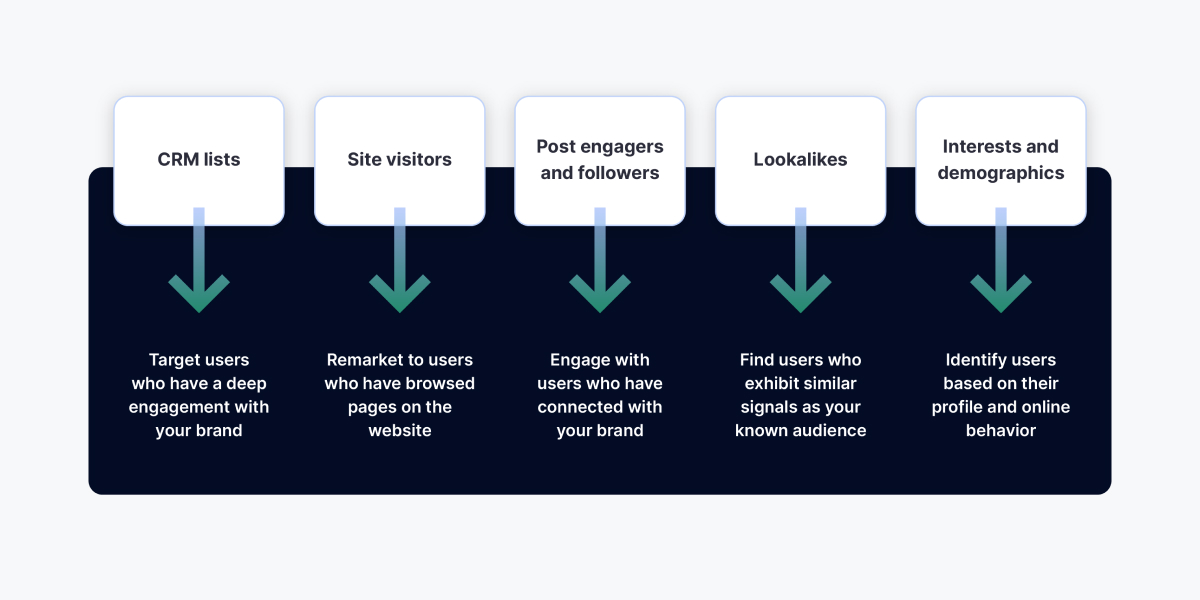
Utilizing audience data for social commerce campaigns
In a recent ebook, Rise discusses the importance of maximizing first-party data (1P data) once you have your ideal campaign structure. First-party data is all the data you have in your CRM, collected from different customer touchpoints, such as mailing list signups, app account creations, website interactions, or purchases. It’s important to look at the frequency and return of these engagements to enhance their lifetime value.
After saturating the pool of qualified 1P users, you’re ready to incorporate additional audience sources, starting with lookalikes. Lookalike audiences find a pool of users that exhibit similar signals as your known audiences, using your 1P data as the source.
Once you have saturated lookalike users, you can move on to native audiences—using interest and behavioral targeting—from all the platforms you are present on. While the quality of interest targeting has declined since iOS 14.5 was released, it still helps narrow in on the right audiences that are specifically attached to the determined subject.
To combat declining quality from native sources and continue diversifying audiences, the next step is to lean into third-party providers. The goal of a third-party audience source is to track different behaviors over the Internet that can allow us to enhance 1P, lookalike, and native audience targeting.
Platform-specific advice for your product ad campaigns
 Meta
Meta
“Meta has the widest and largest audience of any social media platform. From Facebook to Instagram and WhatsApp, there is an entire system of platforms in the Meta ecosystem that spans age, gender, behaviors, and demographics. Meta provides an unmatched ability to efficiently scale your performance marketing. With Meta Advantage, Meta’s suite of automated ad products—from placements to audiences, creative, and budget—you can escalate the value of AI in your campaigns.”
 TikTok
TikTok
“TikTok’s Video Shopping Ads provide the ideal opportunity to make TikToks that also drive conversions using in-feed videos. These shoppable videos take users seamlessly from the For You page to checkout, creating an optimal consumer experience.”
 Pinterest
Pinterest
“Pinterest is a unique combination of social media and search. A user’s search query drives the images and content they are shown based on targeting interests, 1P data, keywords, match types, and more. That means users are actively seeking content from brands, merchants, and creators, and brands need to plan accordingly for their image to be the most relevant search result. The searchable social media platform also built Pinterest Trends, a tool that shows trends based on search volume. Marketers can use this tool to uncover emerging trends and topics for strategy insights and inspiration.”
 Snapchat
Snapchat
“Snapchat’s relationship-building and communication experiences are centered on the camera. The camera brings everything to life, and the platform's immersive ad units reflect that core focus. Snapchat’s Shoppable AR Lens seamlessly integrates AR’s “try-on” capabilities with a larger focus on driving sales. Plus, their Lens Web Builder is a no-coding-necessary tool that builds AR Lenses in a matter of minutes, with no 3D skills required.”
Sequenced messaging strategy
In order to get the best return, you need to nurture your target audiences from discovering possibilities to completing a purchase. Rise’s approach to tailored communication is called sequenced messaging. Sequenced messaging means you build your creative and messaging specifically for the desired ad unit or platform based on where the user is in their shopping journey.
Sequenced messaging example
1. Discovery
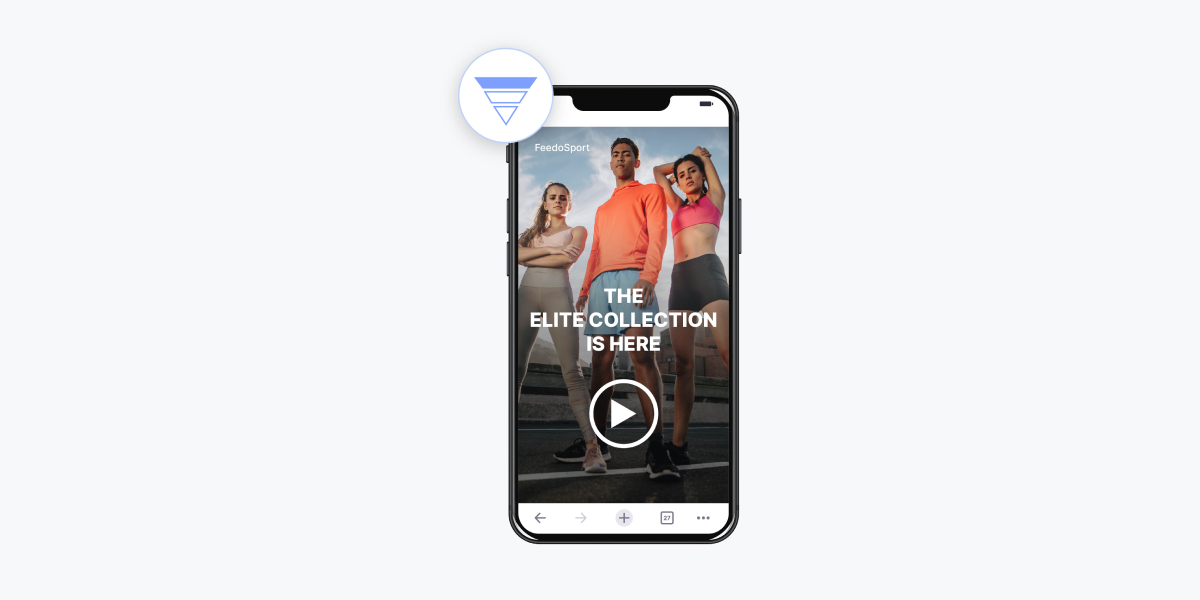
Someone is new to your brand and doesn’t know what’s available yet. You serve them a video asset where you explain who you are beyond your products.
2. Consideration
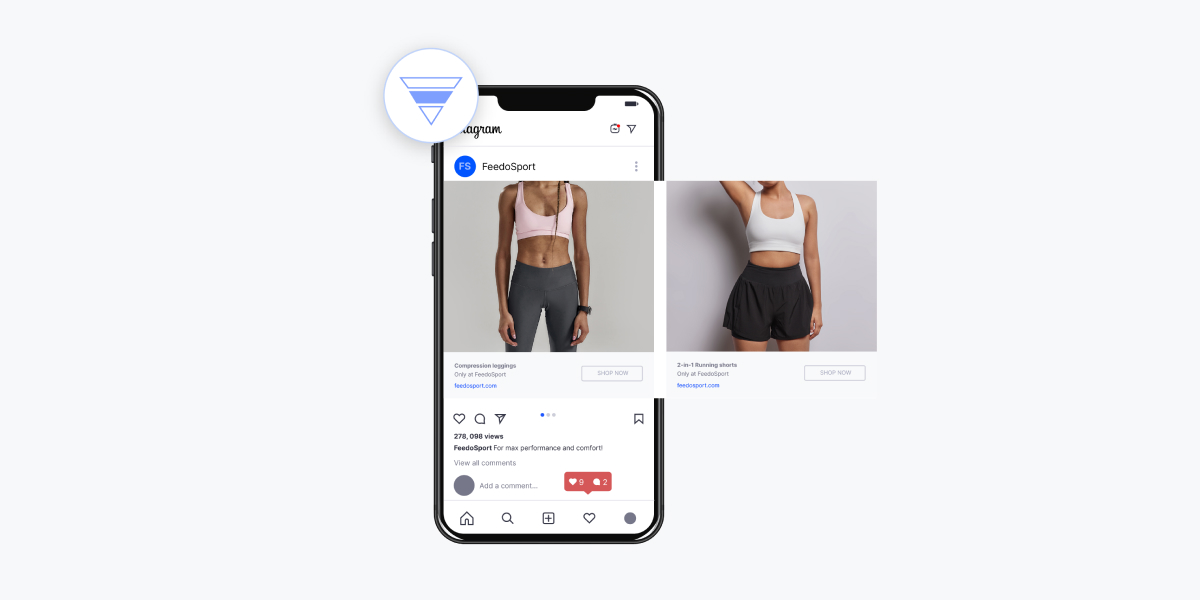
They clicked through your video ad to the site and looked at different products. You follow up with a carousel ad that displays the products they searched for and complementary ones to further tell the story.
3. Purchase
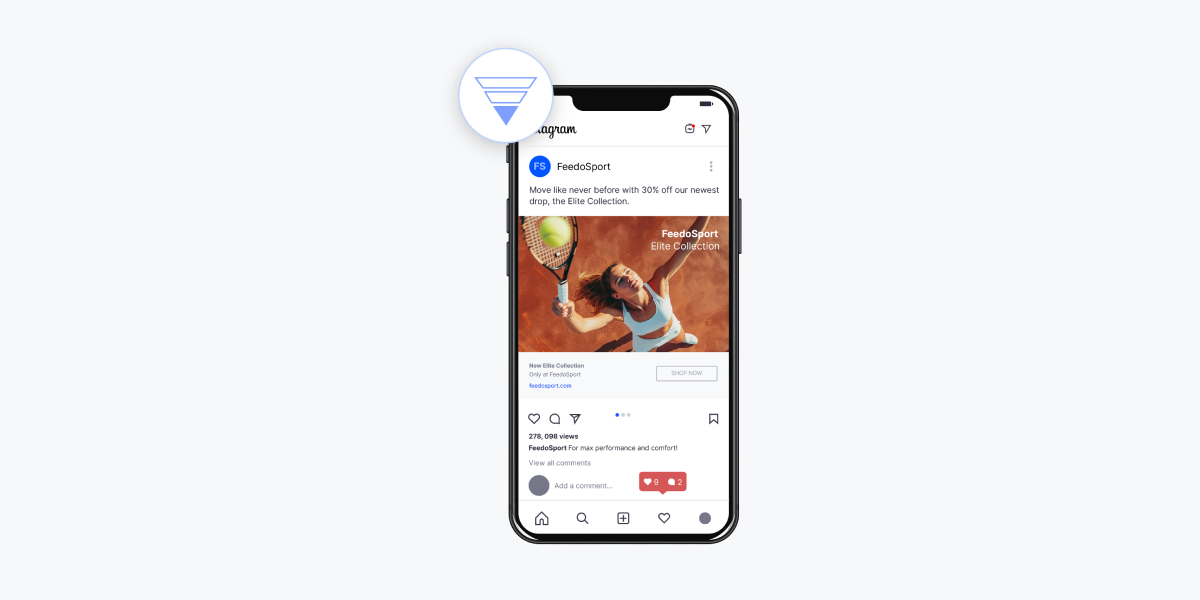
Once they show buying signals, like visiting your website a second time or adding a product to their cart, you serve them a conversion ad with a strong call to action. These can include deals and offers to create a sense of urgency.
“While all of this creative planning can seem overwhelming, incorporating tactic-specific assets and ad units makes a monumental impact on your results. Consider rolling out your elevated social commerce creative in phases as you work to have the right assets and input-ready data for each feature.”
Future of social commerce
Social commerce platforms become integral to omnichannel strategy
“Social commerce will continue to play a larger role in how customers find and try brands for the first time and how customers are exposed to new products from those brands. It will expand to every platform with a sizable, engaged audience and become a staple part of commerce. It will also create a space for new platforms optimized for social commerce. Social commerce will be front and center as an entry point for building a community of new customers and make its way into the planning and budget of every brand. Building competencies in social commerce now—like strategic planning, creator recruitment, community building, creative amplification with ads and measurement—will produce a massive return on investment in the coming years as social commerce grows.”
Short-form and live videos are here to stay
Short-form video has absolutely blown up across social media channels. Many of today’s users prefer bite-sized content to longer forms that require a larger time investment. Gen Z and millennials are particularly interested in this content, evidenced by the explosive growth of TikTok and the short video formats that are now available across most platforms.
According to Forbes, 91% of Instagram users watch videos on the platform weekly, with videos approximately 26 seconds long receiving the most comments.
This format has been shown to offer some of the highest return on investment among other content types, making it a priority for marketers.
In 2023, a Sprout Social report showed that 66% of users find short-form videos to be the most engaging type of content. Another survey by Wyzowl found that 73% of consumers prefer to watch short-form videos when learning about a product or service.
Live video is another powerful tool that has been steadily growing in the U.S. and has taken off much more rapidly in Asian markets. In the U.S., 37% of consumers found streaming to be the most engaging type of content, with audiences aged between 35 and 54 accounting for 39% of Facebook Live viewership, compared to 28% coming from those aged between 18 and 34. On the other hand, Instagram and TikTok Live are much more popular with those younger audiences, accounting for more than 40% of their viewership.
Facebook Live and TikTok Live allow you to tag products in your live streams, but live videos are particularly special in that you are connecting with people who are actively seeking direct real-time interaction with you. This format is particularly effective for product demonstrations and answering customer queries on the spot.
The world’s most successful brands use Feedonomics to integrate with social commerce channels and optimize their product feeds for peak performance.

Muhammed is a content marketing specialist creating informative content to help ecommerce professionals solve industry challenges and stay ahead of the curve.
